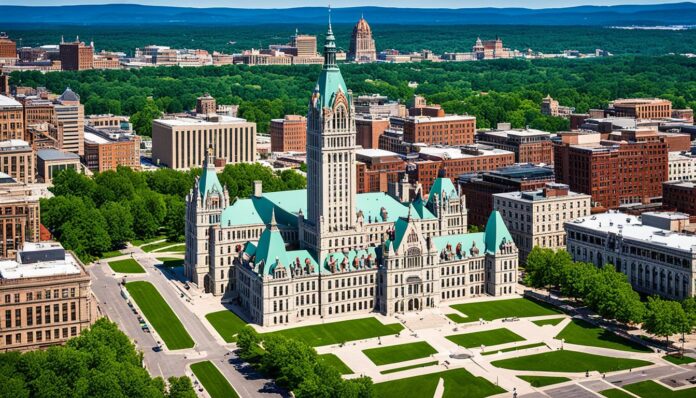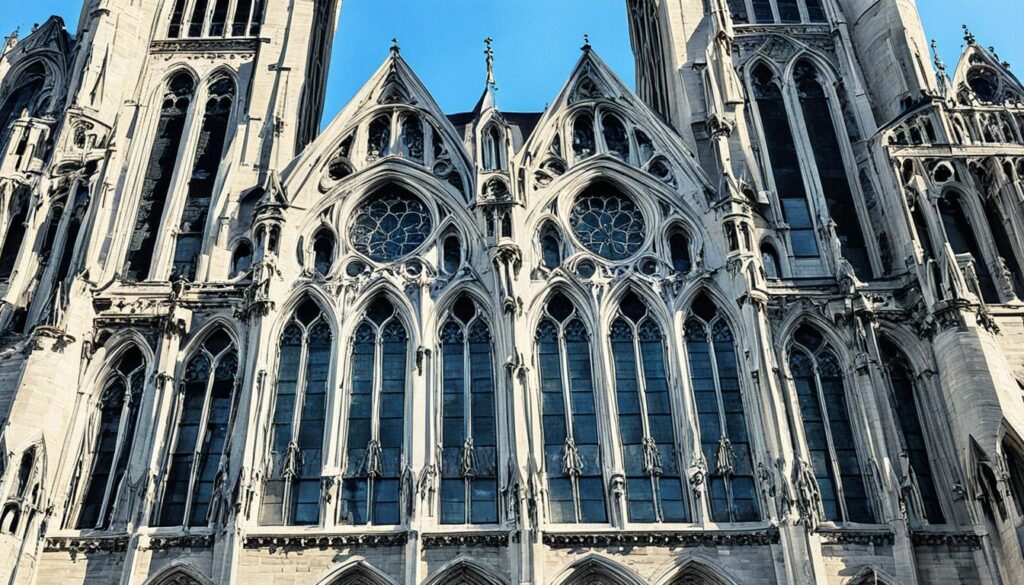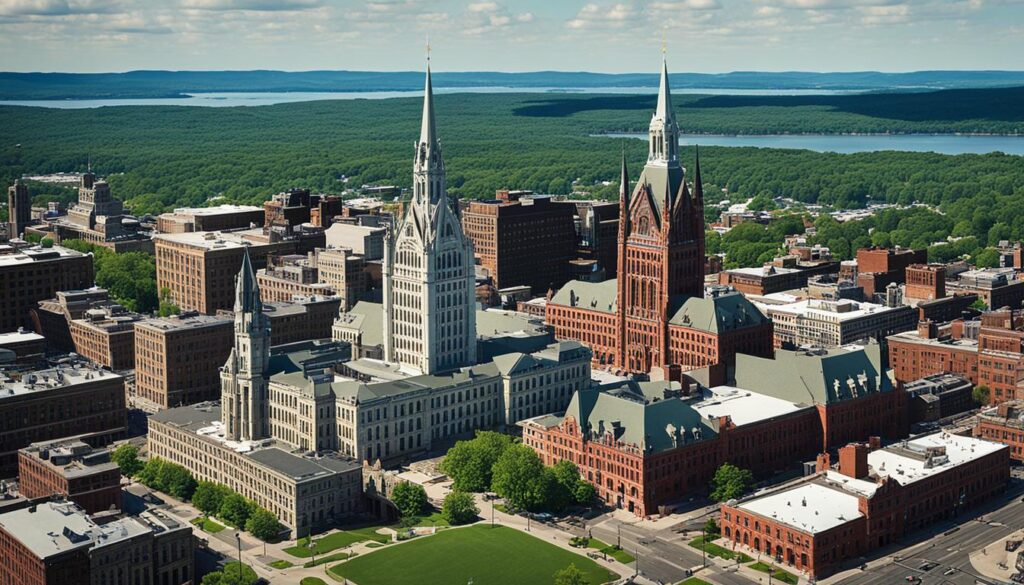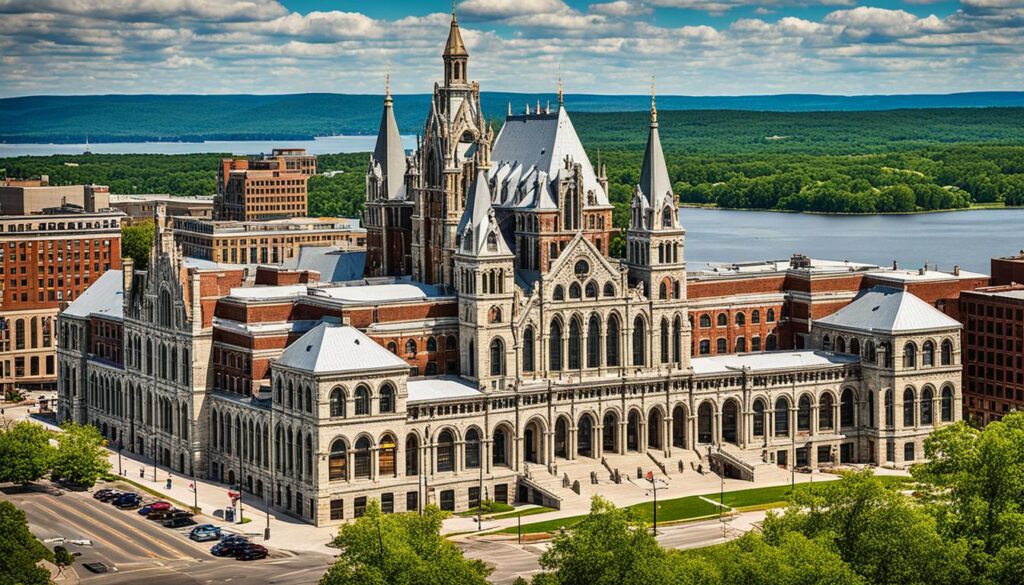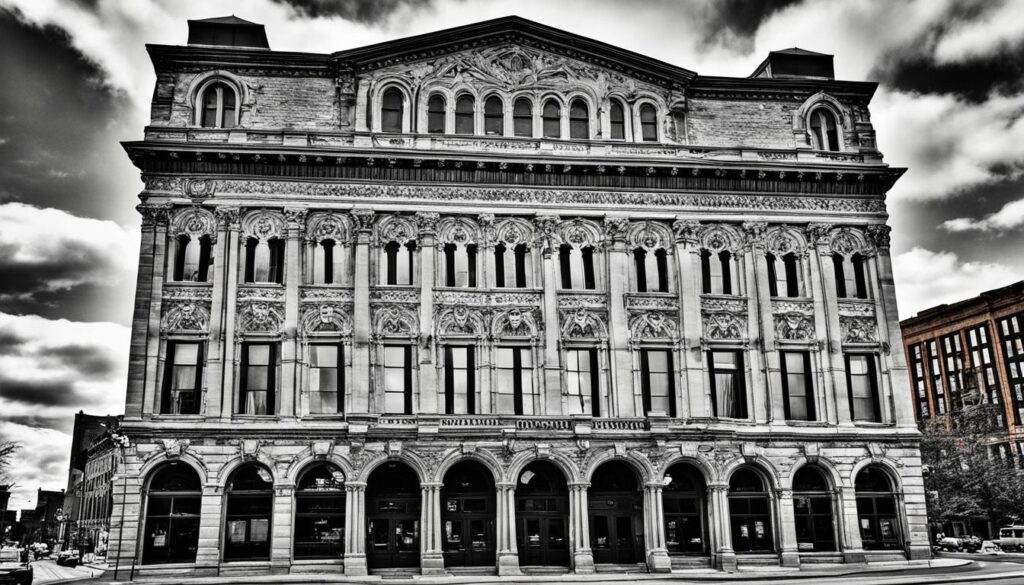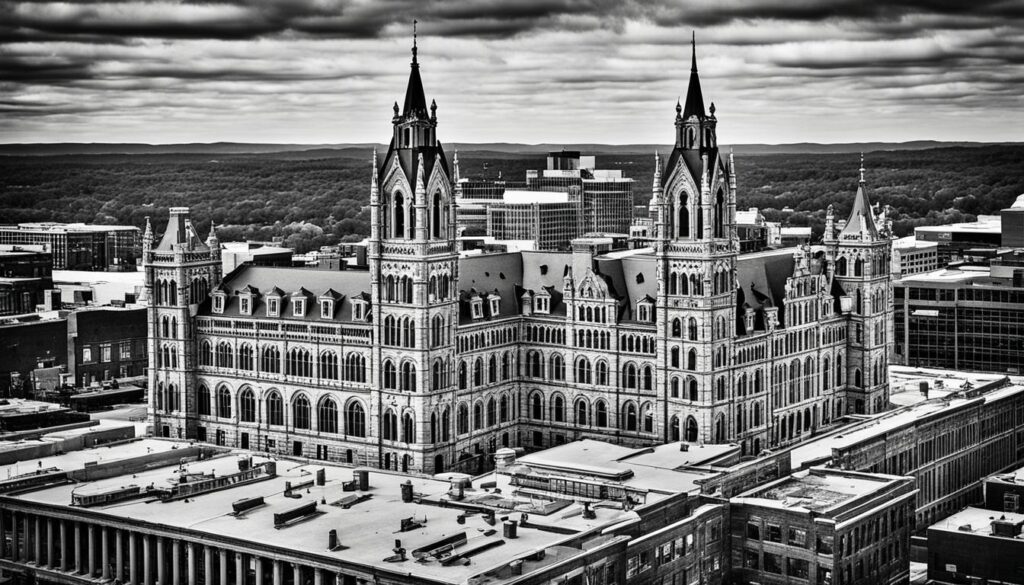Have you ever wondered what stories are etched within the walls of historic buildings? Or how a city like Albany preserves its architectural heritage while embracing the future? Step into the world of Albany’s captivating architecture and embark on a journey through time.
Albany, the capital of New York, is a treasure trove of architectural wonders that reflect the city’s rich history and cultural tapestry. From colonial influences to 19th-century grandeur, each era has left its mark on Albany’s landscape.
Intrigued by the secrets these buildings hold? Venture with us as we unravel the fascinating stories behind Albany’s architectural gems, explore its notable landmarks, visit preserved historic sites, and delve into the importance of historic preservation in this bustling city.
Join us on this immersive journey through Albany’s architectural heritage and discover why these buildings are more than just brick and mortar – they are windows into the past and a testament to the city’s enduring spirit.
A Glimpse into Albany’s Architectural History
Delve into the architectural history of Albany, where centuries-old buildings tell the story of the city’s past. From colonial influences to the rise of industrialization, each era has left its mark on Albany’s architectural landscape.
Albany, the capital city of New York, boasts a rich heritage of architectural styles that reflect its evolving history. The city’s architectural journey begins with its colonial roots, as seen in the Dutch and English influences on its early buildings. The Dutch influence is particularly evident in the use of steeply pitched roofs and ornate gables, while the English influence is reflected in the use of brick and Georgian-style designs.
As Albany grew and industrialization took hold in the 19th century, the architectural landscape transformed. The city embraced styles like Greek Revival, Gothic Revival, and Italianate, with grand buildings adorned with elaborate details, such as ornate facades, towering columns, and intricate ironwork.
The 20th century brought a wave of modernism to Albany, with the rise of Art Deco and International Style architecture. Notable examples include the Empire State Plaza, a modernist complex designed by Wallace Harrison, and the W.A. Harriman State Office Building Campus, featuring sleek lines and geometric shapes.
Today, Albany continues to evolve while preserving its architectural heritage. Historic preservation efforts ensure that iconic buildings are restored and maintained, allowing visitors and residents alike to marvel at the city’s rich past.
Embark on a journey through Albany’s architectural history and witness the merging of artistic styles, cultural influences, and historical significance. As you stroll through the city streets, take in the beauty of Albany’s architectural treasures that chronicle its past and offer a glimpse into its vibrant future.
Albany’s Notable Historic Buildings
Marvel at Albany’s collection of famous buildings that have become iconic landmarks in the city. Each of these historic treasures holds its own unique significance and contributes to Albany’s architectural legacy, showcasing the city’s rich history and culture.
One of the most prominent buildings in Albany is the State Capitol. This magnificent architectural marvel stands as a testament to the grandeur of the city’s past. Designed by renowned architect Henry Hobson Richardson, the State Capitol features a stunning mix of Romanesque and Renaissance Revival styles. Its distinctive silhouette and ornate detailing make it a true architectural gem.
Another notable building in Albany is the Palace Theatre. This historic theater, originally built in 1931, embodies the elegance of the Art Deco era. With its grand entrance, opulent interiors, and world-class performances, the Palace Theatre continues to captivate audiences and preserve the city’s love for the performing arts.
For a taste of Albany’s rich religious history, visit the Cathedral of the Immaculate Conception. This magnificent Gothic Revival cathedral, constructed in the late 19th century, is a true architectural masterpiece. Its towering spires, intricate stained glass windows, and serene atmosphere make it a must-visit for both locals and tourists.
Take a journey back in time with a visit to the Albany City Hall. This stunning Beaux-Arts style building, completed in 1883, served as the city’s seat of government for over a century. Its grand entrance, ornate marble interiors, and iconic clock tower make it a symbol of Albany’s civic pride.
Other notable historic buildings in Albany include the New York State Museum, the Albany Institute of History & Art, and the Albany City Savings Bank. Each building tells a unique story and offers a glimpse into Albany’s vibrant past.
Discover the beauty and significance of these famous buildings in Albany, as they stand as testaments to the city’s rich architectural heritage and cultural identity.
| Building | Architectural Style | Year Completed |
|---|---|---|
| State Capitol | Romanesque and Renaissance Revival | 1899 |
| Palace Theatre | Art Deco | 1931 |
| Cathedral of the Immaculate Conception | Gothic Revival | 1852 |
| Albany City Hall | Beaux-Arts | 1883 |
| New York State Museum | Neoclassical | 1976 |
| Albany Institute of History & Art | Italianate | 1909 |
| Albany City Savings Bank | Second Empire | 1874 |
Exploring Albany’s Historic Places
Embark on a journey to Albany’s historic places, where you can step back in time and immerse yourself in the city’s storied past. Witness the architectural wonders that have stood the test of time, offering a glimpse into Albany’s early days.
Ten Broeck Mansion
One of Albany’s most cherished historic sites is the Ten Broeck Mansion, an elegant Federal-style home that dates back to the late 18th century. Explore the meticulously preserved rooms and stunning gardens, and experience the grandeur that characterized Albany’s prosperous elite. The mansion serves as a window into the city’s affluent past.
Schuyler Mansion
Another noteworthy site is the Schuyler Mansion, an exquisite Georgian-style residence that was home to one of Albany’s most prominent families. Immerse yourself in the Schuyler family’s fascinating history and gain insights into their contribution to American independence. This beautifully restored mansion offers a glimpse into the lifestyle and aspirations of Albany’s early elite.
These historic sites, along with many others, are testaments to Albany’s rich heritage and the significance it holds in American history. They stand not only as architectural marvels but also as reminders of the stories and lives that have shaped the city.
“Exploring Albany’s historic places allows you to connect with the city’s past and appreciate its architectural legacy.” – Albany Preservation Society
Take a moment to imagine the tales these historic places could tell if their walls could speak. Each visit provides an opportunity to delve into the narratives woven into Albany’s fabric, granting a deeper understanding of the city’s cultural heritage.
Embarking on a journey through Albany’s historic places rewards you with a heightened appreciation for the city’s architectural treasures and the stories they hold. From exploring the grand halls of the Ten Broeck Mansion to immersing yourself in the elegance of the Schuyler Mansion, each visit allows you to travel back in time and gain a profound understanding of Albany’s illustrious past.
Albany’s Architectural Landmarks
Explore the architectural landmarks that define Albany’s skyline, showcasing a fusion of architectural styles from neoclassical to Gothic revival. These iconic buildings not only contribute to the city’s charm but also serve as a testament to its rich history and cultural heritage.
One of the most prominent landmarks is the Empire State Plaza. This stunning complex, designed by renowned architect Wallace Harrison, features a striking mix of modernist architecture and open spaces. With its iconic Corning Tower, The Plaza stands as a symbol of Albany’s progress and modernity.
Another notable architectural gem is St. Peter’s Church. Located in the heart of Albany’s historic district, this Gothic revival masterpiece is adorned with intricate stonework and stained glass windows. It has been a spiritual and architectural pillar for the Albany community since its construction in 1859.
The Albany City Hall is yet another architectural marvel worth visiting. Designed by renowned architect Henry Hobson Richardson, this Romanesque-style building stands as a testament to Albany’s rich architectural legacy. Its towering presence and intricate detailing make it a true gem in the city’s skyline.
Explore these architectural landmarks and more as you venture through Albany’s streets. Each building tells a unique story, shaping the character of this historic city.
| Architectural Landmark | Architectural Style | Year Built |
|---|---|---|
| Empire State Plaza | Modernist | Completed in 1976 |
| St. Peter’s Church | Gothic Revival | Constructed in 1859 |
| Albany City Hall | Romanesque | Built in 1883 |
The Importance of Historic Preservation in Albany
Preserving the architectural heritage of Albany is essential to safeguarding the city’s rich history and cultural identity. Historic buildings not only serve as tangible links to the past but also contribute to the unique character of Albany’s urban landscape.
By protecting and restoring Albany’s historic buildings, future generations can appreciate and learn from the architectural achievements of the past. These buildings provide a glimpse into the different eras and influences that have shaped Albany’s development over time.
“Preserving historic buildings is not merely an act of nostalgia; it is an investment in the future. These architectural treasures tell stories that inspire and educate, fostering a sense of pride and appreciation for our shared heritage.” – Albany Historic Preservation Commission
Through diligent preservation efforts, Albany ensures that its historic architecture remains intact and accessible for public enjoyment. This commitment to preservation extends to both notable landmarks and lesser-known gems tucked away in historic neighborhoods.
By maintaining the integrity of Albany’s historic buildings, the city also benefits from increased tourism and economic development. Historic preservation attracts visitors who are drawn to the distinct charm and authenticity that these architectural treasures offer.
Preserving Albany’s Historic Buildings: A Collaborative Effort
Preserving Albany’s historic architecture is not the sole responsibility of any one entity. It requires a collaborative effort between government agencies, preservation organizations, property owners, and the community.
The Albany Historic Preservation Commission plays a vital role in identifying and designating historic buildings and districts, providing guidance on preservation efforts, and advocating for policies that protect Albany’s architectural heritage.
Property owners also play a critical part by maintaining and restoring their historic buildings in adherence to preservation guidelines. Through tax incentives and grant programs, the City of Albany supports property owners in their efforts to preserve these valuable architectural assets.
Community involvement is key to ensuring the success of historic preservation in Albany. By building awareness, fostering appreciation, and engaging in preservation initiatives, the community contributes to the long-term sustainability of Albany’s historic buildings.
Albany’s commitment to historic preservation is evident in the careful restoration and adaptive reuse of its architectural treasures. This dedication ensures that future generations can continue to experience the beauty and significance of Albany’s historic buildings.
Albany’s Architectural Gems
As you wander through Albany’s historic neighborhoods, you’ll uncover an array of hidden architectural gems that showcase the city’s rich history and diverse styles. From elegant Victorian houses to stately Georgian mansions, these buildings offer a glimpse into Albany’s architectural legacy.
Step back in time as you admire the intricate details and craftsmanship of these architectural treasures. Each structure tells a story, reflecting the architectural tastes and influences of the era in which it was built.
Marvel at the meticulously preserved Victorian houses, characterized by their ornate details, vibrant colors, and picturesque front porches. These charming residences transport you to a bygone era, evoking a sense of nostalgia and elegance.
On the other hand, the Georgian mansions exude a timeless grandeur with their symmetrical facades, columned entrances, and expansive gardens. These architectural masterpieces serve as a testament to Albany’s affluent past and the aspirations of its early inhabitants.
Whether you’re an architecture enthusiast or a history buff, exploring Albany’s architectural gems is a truly rewarding experience. The city’s commitment to preserving these historical structures allows you to immerse yourself in the beauty and charm of Albany’s past while appreciating the intricate craftsmanship and design.
Unearth the hidden architectural treasures that lie within Albany’s historic neighborhoods and witness the unique blend of styles that have shaped the city’s identity throughout the years.
Albany’s Architectural Gems at a Glance
| Name | Architectural Style |
|---|---|
| The Ten Broeck Mansion | Georgian |
| The Manning-Myrick House | Victorian |
| The Lustron House | Mid-Century Modern |
| The Governor’s Mansion | Georgian |
| The Van Ostrande-Radliff House | Georgian |
Exploring Albany’s Historic Districts
Immerse yourself in the charm of Albany’s historic districts, where the allure of bygone eras still lingers. These well-preserved neighborhoods are a testament to Albany’s rich architectural heritage, transporting you to a different time and place. Stroll through the tree-lined streets, marvel at the meticulously maintained buildings, and soak in the ambiance of centuries past.
One of the must-visit historic districts in Albany is the Washington Park Historic District. This picturesque neighborhood is home to a stunning collection of Victorian and Georgian-style houses, showcasing the elegance and grandeur of a bygone era. Take in the intricate details and architectural craftsmanship as you explore the streets adorned with these architectural gems.
If you’re looking to experience the vibrant energy of Albany, head to Center Square. This eclectic neighborhood is known for its bustling streets, colorful row houses, and a lively arts scene. It’s a melting pot of architectural styles, with Greek Revival, Italianate, and Second Empire buildings coexisting harmoniously. Enjoy the vibrant atmosphere as you wander through the streets, visit art galleries, and savor local cuisine.
Albany’s historic districts offer a captivating glimpse into the city’s past, preserving its architectural treasures for future generations to admire. Whether you’re a history enthusiast, a architecture lover, or simply looking to immerse yourself in the city’s unique charm, exploring Albany’s historic districts is a journey you won’t want to miss.
Albany’s Architectural Walking Tours
Immerse yourself in the rich architectural wonders of Albany by embarking on guided walking tours. These tours offer a unique opportunity to explore the city’s historic sites and architectural landmarks, providing a deeper understanding of Albany’s architectural heritage.
Join knowledgeable guides who will lead you through the city’s architectural highlights, sharing fascinating stories and insights along the way. Discover the intricate details and craftsmanship of Albany’s historic buildings, from the iconic State Capitol to the charming brownstones of Center Square.
As you stroll through Albany’s historic districts, you’ll witness the diverse architectural styles that have shaped the city over the years. From the neoclassical designs of the Empire State Plaza to the Gothic revival beauty of St. Peter’s Church, each architectural gem tells a story of Albany’s past.
Walking tours provide an up-close and personal experience, allowing you to appreciate the finer details of Albany’s architectural gems. Listen as your guide weaves together the history, stories, and significance behind each landmark, painting a vivid picture of Albany’s past and present.
Whether you’re a history enthusiast, architecture lover, or simply curious about the city’s rich heritage, these walking tours offer an immersive experience like no other. Explore the preservation efforts that have kept Albany’s historic buildings intact and hear the tales of the people who shaped the city.
Uncover hidden architectural gems tucked away in Albany’s historic neighborhoods, each with its distinct character and charm. From the grand Victorian houses of Washington Park Historic District to the elegant Georgian mansions of Ten Broeck Triangle, you’ll be captivated by the beauty and diversity of Albany’s architectural styles.
Don’t miss the opportunity to discover Albany’s architectural treasures firsthand. Lace up your walking shoes, join a guided tour, and embark on a captivating journey through the city’s architectural history.
Why Choose an Architectural Walking Tour?
Architectural walking tours in Albany provide a unique way to experience the city’s history and heritage. Here’s why you should consider joining one:
- Insider knowledge: Knowledgeable guides will provide fascinating insights into Albany’s architectural landmarks and historic sites, offering a deeper appreciation for the city’s past.
- Close-up view: Walking tours allow you to observe the intricate architectural details up close, capturing the beauty and craftsmanship of Albany’s historic buildings.
- Immersive experience: By exploring the city on foot, you’ll have the opportunity to soak in the atmosphere and ambiance of Albany’s historic districts.
- Engaging storytelling: Guides will bring the city’s architectural history to life through captivating stories and anecdotes, making the tour both educational and entertaining.
- Preservation awareness: By participating in a walking tour, you support the efforts to preserve and protect Albany’s architectural heritage for future generations.
Conclusion
Albany’s architecture and historic buildings take you on a captivating journey through the city’s rich past and vibrant present. From the iconic landmarks to the hidden gems, Albany has meticulously preserved its architectural heritage, creating a blend of old-world charm and modern vitality.
As you explore the city, you’ll be awestruck by the stories whispered by the historic buildings. The State Capitol, with its majestic neoclassical design, stands as a testament to Albany’s political significance. The Palace Theatre, a grand entertainment venue, echoes with the glitz and glamour of bygone eras. Each step you take uncovers architectural marvels that showcase the diverse influences that have shaped Albany.
While embracing its historic roots, Albany also looks to the future. The city’s ongoing commitment to historic preservation ensures that these architectural treasures will be cherished for generations to come. Albany’s architectural legacy serves as an inspiration for city planners, architects, and residents alike, creating a thriving community that celebrates its past while embracing progress.
So, whether you’re a history enthusiast, an architecture aficionado, or simply seeking to immerse yourself in the beauty of a bygone era, Albany’s architecture and historic buildings await your discovery. Uncover the hidden stories, breathe in the ambiance of centuries-old structures, and let the magic of Albany’s architectural treasures captivate your senses.




























